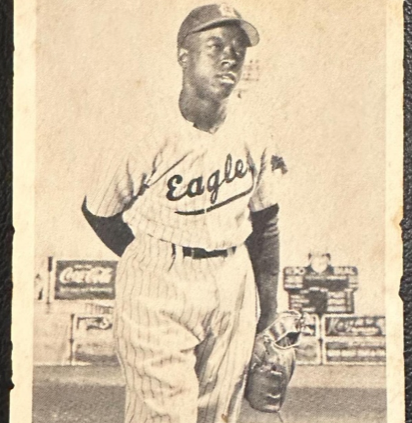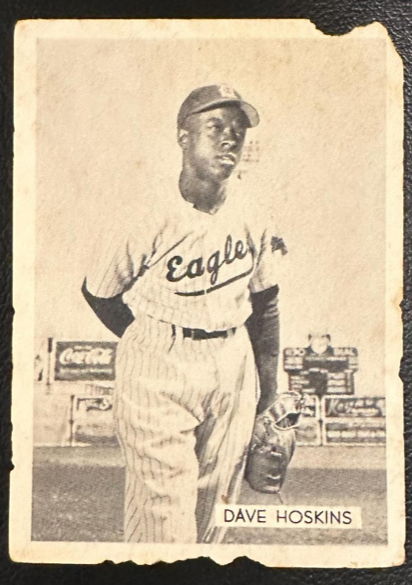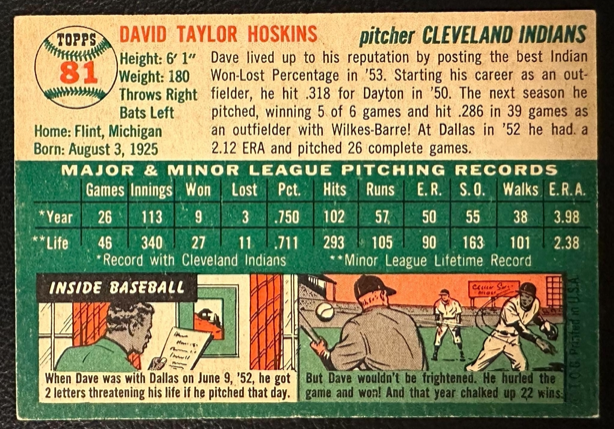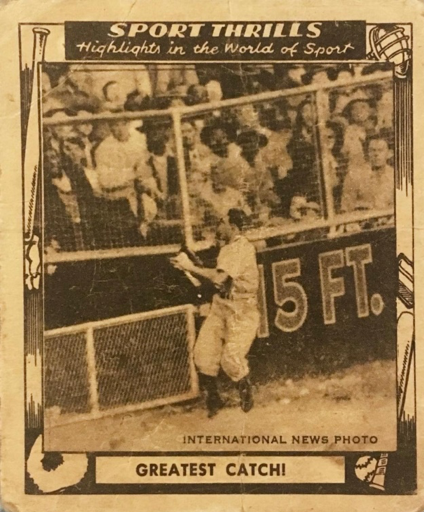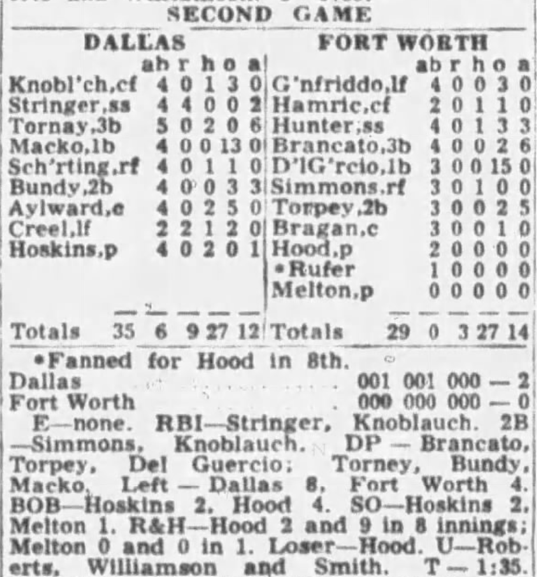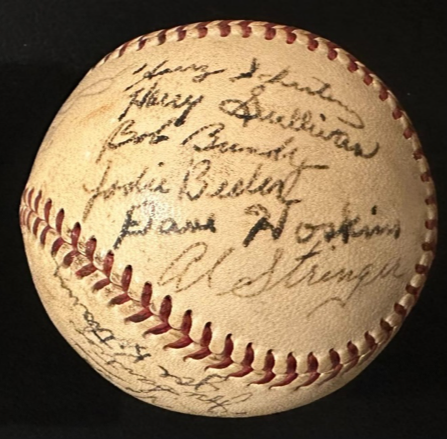August 28, 1952: Dave Hoskins wins 20th game for Dallas Eagles on night held in his honor
1952 Globe Printing Dave Hoskins baseball card
Entering the 1952 season, the Texas League had never seen a player like Dave Hoskins, neither in talent nor complexion. Like Jackie Robinson five years earlier, Hoskins was an experiment. Dallas Eagles owner Richard Burnett wanted a Black man on his team.1 As evidenced by the 200 Black players who tried out only to be turned away, Burnett, like Branch Rickey in the Jackie story, presumed the need for a truly extraordinary player, one who would leave no doubt in the minds of all but the most entrenched bigots that Black men had a place in a league that for 50 years had been a segregation stronghold and bastion of Jim Crow. Burnett sought lightning in a bottle. Remarkably, that’s exactly what he found.
By the time the Eagles (Cleveland Indians Double-A affiliate), made the short drive to LaGrave Field for four games against the Fort Worth (Brooklyn Dodgers affiliate) in late August, Dave Hoskins was not only the league’s winningest pitcher, tied with teammate Hal Erickson at 19 victories, but arguably one of its top batters as well. His .327 batting average sat just 2 points behind the leader, Shreveport’s Grant Dunlap, albeit in far fewer at-bats.2
Perhaps more significantly, the 35-year-old Hoskins was the league’s biggest draw, not just at home but on the road as well, roughly doubling typical attendance figures everywhere he played. Not a bad financial return from the lowest-paid player on the Eagles!3
Despite Hoskins’ great success on the field and at the gate, this is not to say the “savior of the Texas League,” as he was known,4 had it easy. In addition to suffering the standard indignities of being a Black man in 1950s America, Hoskins pitched through insults and even death threats. Of course, none of this was new to him. The fact that Hoskins, a former member of the Homestead Grays’ Murderers Row, even turned to pitching was a consequence of the frequent beanballs he endured hitting full-time as an outfielder on the 1950 Dayton Indians.5
1954 Topps Dave Hoskins card reverse with death threats cartoon
Though fellow Eagle Erickson would soon be voted the league’s top pitcher,6 the evening of August 28 belonged to Dave Hoskins. Literally. Fans of the Fort Worth Cats had declared the date Dave Hoskins Night in honor of the two-way player’s amazing and historic season. (Dallas fans similarly held their own Dave Hoskins Night in Dallas just a week later.7)
Beyond any honors for Hoskins, the night was significant in that its twin bill paired the two teams vying for first place in the eight-club Texas League. Entering the start of play, the Eagles held a two-game lead, meaning they could finish the evening deadlocked atop the standings or potentially up by as many as four games. (While the top four teams would make the playoffs, only the top team at the end of the regular season would receive $5,000 in prize money.8)
The night’s attendance, which included more than 3,000 Black patrons, 9 was 9,671. By comparison, average Texas League attendance to that point in the season had been 2,381.10 At least one estimate put the number of extra tickets sold due to Hoskins at over 90,000 during the season to date11 with Dallas Eagles publicity director Jerry Doggett (who went on to call LA Dodgers games with Vin Scully for more than three decades) estimating another 15,000 nonpaying guests attending Hoskins starts through promotions like Ladies Nights.
In the first game, Don Mossi took the hill for the Eagles and shut out the Cats 2-0, outdueling Elroy Face in an abbreviated seven-inning affair. The win provided Dallas with a three-game cushion in the standings.
In the nightcap, the Eagles pitcher would be Hoskins, the man “local Negro leaders [had] made plans to honor,”12 seeking his league-best 20th win of the season. Opposing Hoskins would be Fort Worth pitcher Wally Hood, an All-American on the University of Southern California’s 1948 College World Series champion team who had appeared in two games for the New York Yankees in 1949.13
Between games of the doubleheader, Hoskins was showered with gifts, and the local NAACP head, Dr. George D. Flemmings, praised the visiting ace, citing his achievements with the Eagles as evidence that Black Americans had earned a place at the table in White America: “Dave Hoskins is proof that we can all live together, work together and play together.”14
As Flemmings continued, crowd reaction was split by race. Wild cheers erupted from the Black fans on hand when Flemmings offered his hopes that someday all Texas League teams, “even Shreveport, Louisiana,” would field Black players. In sharp contrast, a torrent of boos and jeers rained down from White patrons when Flemmings cited the hometown Cats specifically.
“Until such times as the Fort Worth ball club sees fit to use a colored player –” was all that could be heard before the cacophony of the White crowd ultimately forced Flemmings to surrender the microphone to the night’s honoree, whose words of gratitude restored harmony.
Having just calmed the opposing crowd, Hoskins went on to quell opposing bats as well, surrendering only three hits while tossing a shutout to secure his 20th win. As was also the case against Mossi in the opener, no Cats player even reached third base.15 Hoskins surrendered just two singles and a double over nine innings while walking two and striking out two.
Interestingly, all three Cats batters to record hits enjoyed major-league careers. Center fielder Bert Hamric had cups of coffee with the Brooklyn Dodgers and Baltimore Orioles in 1955 and 1958 respectively; shortstop Billy Hunter, a future manager of the Texas Rangers, was an All-Star with the St. Louis Browns in 1953 and played six seasons in all; and right fielder John Simmons spent part of the 1949 season with the Washington Senators.
1948 Swell “Sport Thrills” card of Al Gionfriddo
Three major leaguers were also among the Fort Worth O-fers. Left fielder and leadoff hitter Al Gionfriddo, whose great catch five years earlier robbed Joe DiMaggio of a home run in the 1947 World Series, was hitless in four at-bats as was the team’s third baseman, former Philadelphia Athletic Al Brancato. Finally, manager-catcher Bobby Bragan, who in 1947 asked Branch Rickey for a trade upon learning he would team with Jackie Robinson, finished the contest 0-for-3.16
The evening also proved a showcase for Hoskins at the plate as the two-way sensation contributed to both Eagles runs.17 In the third inning, his single advanced left fielder Jack Creel, who had opened the frame with a walk, to second base, from which he went on to score on successive fielder’s choices by Edward Knoblauch18 and Al Stringer. Three innings later, a Hoskins single once again advanced Creel to second, positioning him to score on a Knoblauch ground-rule double.
Notably, the two hits by Hoskins also lifted his batting average to .3309, temporarily eclipsing the .3303 average of Texas League batting leader Grant Dunlap.19 Fellow Eagles Frank Tornay and Dick Aylward20 each collected a pair of hits as well.
Box score from the Tulsa Tribune21
The regular season ended two weeks later with the Eagles atop the standings by six games, and Hoskins finished 22-10 with a stingy 2.12 ERA. His .327 batting average was only 2 points lower than that of league leader Babe Martin, though insufficient plate appearances precluded any formal finish in the batting race.
On the strength of his 1952 season in Dallas, Hoskins punched his ticket straight to the big leagues.22 Said owner Richard Burnett, “He’s in a position now to make some money. I only wish I could keep him.”23
In truth, Burnett – and every major league and minor league owner – had access to a tremendous pool of Black talent, just as they had for decades. Yes, Hoskins was a special player, but was he unique in his qualifications? Burnett, like Branch Rickey, warrants kudos for being first, but this is an area where first and fast are not the same. Either way, the resounding success of Hoskins earned Burnett a postseason award from the local YMCA as “The One Who Has Done Most to Improve Race Relations in 1952.”24
Official league ball signed by 1952 Dallas Eagles
Postscript
For all the success Hoskins brought to the Eagles during the 1952 regular season, both on the field and at the turnstiles, Jim Crow may have fared even better when we look to the postseason and the years that followed. The hosts of Dave Hoskins Night, the Fort Worth Cats, were ousted from the 1952 postseason by the Oklahoma City Indians and did not relax their own color barrier until the 1955 signing of future National League MVP Maury Wills. Meanwhile, the Shreveport Sports – singled out by the NAACP’s Dr. Flemmings as the team least likely to integrate – swept the Hoskins-led Eagles in the first round of the playoffs, went on to capture the championship, and remained an all-White franchise for the remainder of their existence.
Acknowledgments
Louis Moore kindly shared access to the research file he compiled in writing about Hoskins in his book, We Will Win the Day: The Civil Rights Movement, the Black Athlete, and the Quest for Equality.
The family of Mr. Hoskins graciously shared their collection of notes and news clippings.
Linda Barrett of the Fort Worth History Center located and provided articles from the Fort Worth Press that had not yet been digitized or made available through microfiche.
This article was fact-checked by Kevin Larkin and copy-edited by Len Levin.
Photo Credits
Dave Hoskins baseball cards and 1952 Dallas Eagles signed ball from author’s personal collection.
Al Gionfriddo baseball card appears courtesy of Chad Simmons.
Sources
In addition to the sources cited in the Notes below, the author consulted Baseball-Reference.com for pertinent information.
Notes
1 Larry G. Bowman, “Burnett, Richard Wesley,” Texas State Historical Association, accessed May 12, 2023, https://www.tshaonline.org/handbook/entries/burnett-richard-wesley.
2 Prior to the start of action on August 28, Grant Dunlap had 420 at-bats to only 111 for Hoskins. Note that a SABR Oral History Project interview with Grant Dunlap is available at https://sabr.org/interview/grant-dunlap-2000/.
3 “Fort Worth Holds Night for Dave Hoskins,” Jet Magazine, September 11, 1952: 54.
4 “Fort Worth Holds Night for Dave Hoskins.”
5 James “Mudcat” Grant, Black Aces (Farmingdale, New York: The Black Aces LLC, 2006).
6 “Hal Erickson Rated Top TL Pitcher,” Dallas Morning News, September 27, 1952: 11. The honor may not have been solely on merit as Hoskins topped Erickson in victories, winning percentage, and earned-run average when the award was announced.
7 Dave Hoskins Night in Dallas was held on September 3, 1952. Per an ad in that day’s Dallas Morning News, the event was “sponsored by Negro citizens of Dallas with the assistance of some prominent white baseball fans.” The newspaper reported the next day that Hoskins received $2,500 in war bonds as well as numerous other gifts.
8 Blackie Sherrod, “Twinbill Tonight Blue Chip Special,” Fort Worth Press, August 28, 1952: IV, 1.
9 Blackie Sherrod, “More Woe Than Woah,” Fort Worth Press, August 29, 1952: 14. Black attendance was reported as 3,308.
10 “Former Barons Hurler Wins 20th Contest,” Wilkes-Barre (Pennsylvania) Times Leader, August 29, 1952: 21.
11 “Fort Worth Holds Night for Dave Hoskins.”
12 Sherrod, “Twinbill Tonight Blue Chip Special.”
13 Hood was selected to the National Collegiate Baseball Hall of Fame in 2019. His father, also named Wally Hood, appeared in 67 games with the Brooklyn Robins and Pittsburgh Pirates from 1920 through 1922 and worked as a Pacific Coast League umpire from 1935 through 1944. “Wally Hood Named to 2019 College Baseball Hall of Fame Class,” USCTrojans.com, August 22, 2019, https://usctrojans.com/news/2019/8/22/wally-hood-named-to-2019-college-baseball-hall-of-fame-class.
14 Sherrod, “More Woe Than Woah.”
15 Sherrod, “More Woe Than Woah.”
16 Bragan’s reluctance to team with Robinson was depicted in the 2013 movie 42, where Bragan was portrayed by actor Derek Phillips.
17 “Eagles Edge Cats Twice to Gain 4-Game TL Lead,” Dallas Morning News, August 29, 1952: 12.
18 Edward Knoblauch’s nephew, Chuck Knoblauch, played 12 major-league seasons and received 1991 American League Rookie of the Year honors.
19 “Former Barons Hurler Wins 20th Contest.”
20 Aylward, a catcher, played four games with the Indians in 1953, primarily as a defensive replacement.
21 “Hoskins in 20th Win as Eagles Soar,” Tulsa Tribune, August 29, 1952: 36.
22 Hoskins played two seasons with the Cleveland Indians, compiling a record of 9-4 with a 3.81 ERA. The majority of his appearances were in relief as the Indians’ four-man starting rotation (Early Wynn, Bob Lemon, Bob Feller, Mike Garcia) was arguably the best in the majors.
23 “Fort Worth Holds Night for Dave Hoskins.”
24 Louis Moore, We Will Win the Day (Lexington, KY: University Press of Kentucky, 2021), 50.
Additional Stats
Dallas Eagles 2
Fort Worth Cats 0
Game 2, DH
LaGrave Field
Fort Worth, TX
Corrections? Additions?
If you can help us improve this game story, contact us.


